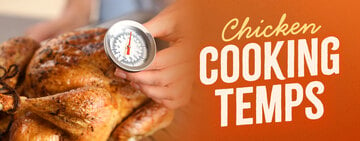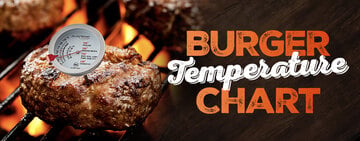How to Use a Meat Thermometer
Last updated on Sep 17, 2024Michale LeRoyPrecision is key when it comes to cooking meat, and that's why a meat thermometer comes in handy. Professional chefs rely heavily on the accuracy of meat thermometers to ensure food safety and quality. Whether you're running a restaurant, a catering business, or a food truck, knowing how to use a meat thermometer is essential. We'll walk you through the steps of using a meat thermometer so that your proteins are cooked perfectly every time.
Meat Thermometer Video
Watch the video below to learn the proper way to use a meat thermometer.
What Is a Meat Thermometer?
A meat thermometer is a type of thermometer designed to accurately measure the internal temperature of meat. This helps you determine whether your meat is cooked to the desired level of doneness, whether it's rare, medium, or well-done. But it's not just about personal preference; using a meat thermometer is critical for food safety as well.
When cooking meat, it's crucial to reach the right internal temperature to kill any harmful bacteria that may be present. Different types of meat have different safe minimum internal temperatures, and using a meat thermometer takes the guesswork out of knowing when your meat is cooked through.
Types of Meat Thermometers
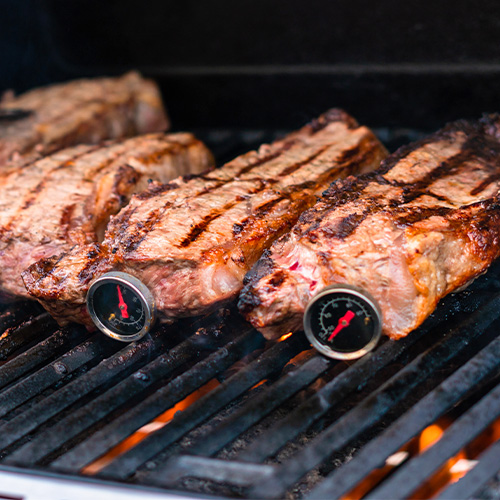
There are several types of meat thermometers available on the market, each with its own unique features and benefits.
- Oven-Safe or Leave-In Thermometers: These thermometers are designed to be left in the meat throughout the cooking process, even when grilling or smoking. This way you know immediately when your steak or roast has come to temperature so you don't overcook it.
- Probe Thermometers: Probe thermometers consist of a long metal probe attached to a digital display unit. The probe is inserted into the meat, and the display unit shows the temperature reading. These thermometers are versatile and can be used for various cooking methods, including grilling, baking, and frying. They are available in both analog and digital readouts, offering flexibility and convenience.
- Wireless Thermometers: If you want to monitor the temperature of your meat from a distance, wireless thermometers are the way to go. These thermometers consist of a probe that is inserted into the meat and a transmitter that sends the temperature readings wirelessly to a receiver unit. The receiver unit can be carried around, allowing you to keep an eye on the cooking progress without being tied to the grill or oven. Wireless thermometers are perfect for outdoor cooking or when multitasking in the kitchen.
How to Use a Meat Thermometer the Right Way
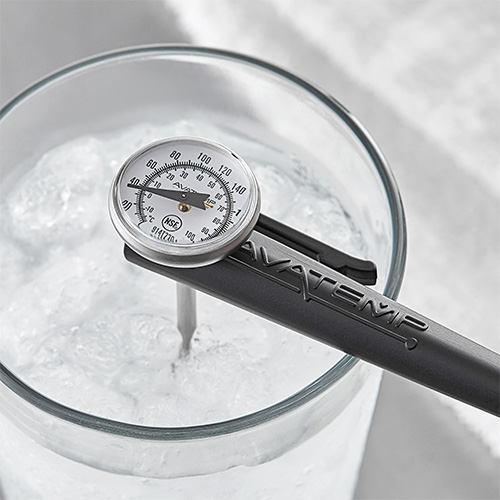
Follow these steps to use a probe thermometer to check the internal temperature of meat:
- Calibrate your thermometer: Calibrating a meat thermometer is crucial to ensure accurate temperature readings, especially when it comes to food safety. One simple and effective method to calibrate your meat thermometer is by using ice water. Start by filling a glass with ice cubes and then add cold water until the glass is full. Stir the mixture gently to ensure even temperature distribution. Insert the thermometer probe into the ice water, making sure it doesn't touch the sides or bottom of the glass. Wait for the thermometer reading to stabilize, which should be at or very close to 32 degrees Fahrenheit (0 degrees Celsius). If the reading is off, consult your thermometer's manual for calibration instructions or consider purchasing a new thermometer.
- Clean and sanitize: Before and after each use, thoroughly clean and sanitize your thermometer to prevent cross-contamination. Use warm, soapy water to clean the probe, and then sanitize it with a food-safe sanitizer.
- Insert the thermometer correctly: When using a probe thermometer, insert the probe into the thickest part of the meat, avoiding any bones or fatty areas. Ensure that the probe is inserted deep enough to reach the center of the meat without touching any bones or the cooking surface. For burgers or thin cuts of meat, don't insert the probe from the top. Instead, insert the thermometer into the side so that it reaches the center.
- Wait for the reading: Allow the thermometer to stabilize and give an accurate reading. This may take a few seconds for instant-read thermometers or a few minutes for probe thermometers. Avoid removing the thermometer too quickly, as this can result in an inaccurate reading.
Meat Thermometer FAQ
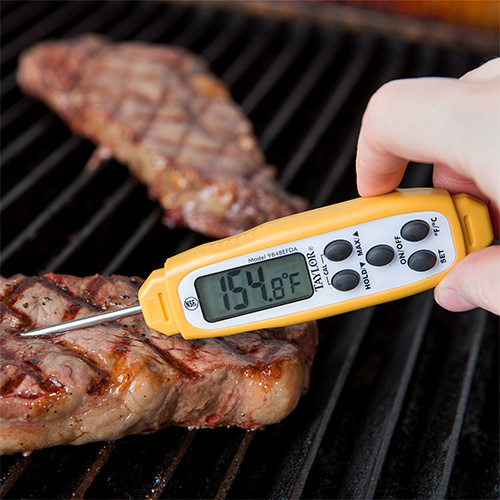
We answer common questions about meat thermometers below:
Can You Leave a Meat Thermometer in While Cooking?
Yes, you can leave a meat thermometer in while cooking if it's rated as an oven-safe or leave-in thermometer. These thermometers are designed to handle the high heat of the oven or cooking surface.
What's the Right Way to Insert a Meat Thermometer?
The goal is to insert the meat thermometer into the thickest part of the meat. For roasts, this means inserting the probe into the center of the thickest part. This will give you the most accurate reading of the meat's internal temperature. When it comes to a whole chicken or turkey, the best place to insert the meat thermometer is into the breast. The breast is typically the thickest part of the bird, and inserting the probe here will give you an accurate reading of the meat's temperature. Thinner cuts of meat like steaks, chops, and burgers require a different method. Instead of inserting the probe vertically, you'll want to insert it horizontally into the center of the meat. This will ensure that the thermometer is measuring the temperature at the thickest part of the cut.
How to Read a Meat Thermometer Dial
The dial on an analog meat thermometer is typically marked with different temperatures and levels of doneness. As the internal temperature of the meat rises, the needle on the dial will move accordingly. Make sure to read the temperature once the needle has stopped moving to get an accurate reading. Remember, different types of meat have different recommended internal temperatures for safe consumption, so consult a food safety guide or recipe to determine the appropriate temperature for your specific dish.
By following these simple steps and using a meat thermometer correctly, you can ensure that your commercial kitchen produces safe and delicious food every time. So, whether you're grilling steaks, roasting a turkey, or smoking a brisket, don't forget to rely on the accuracy of a meat thermometer.

